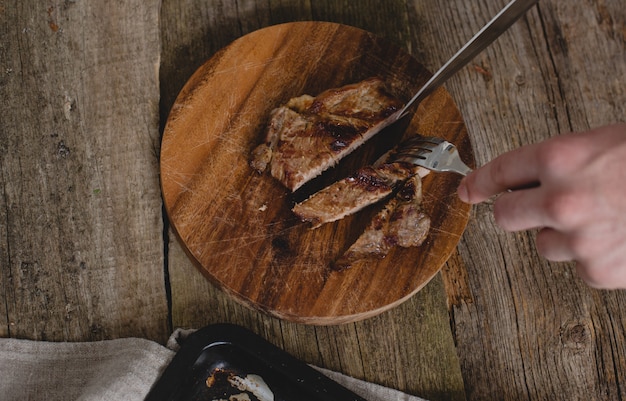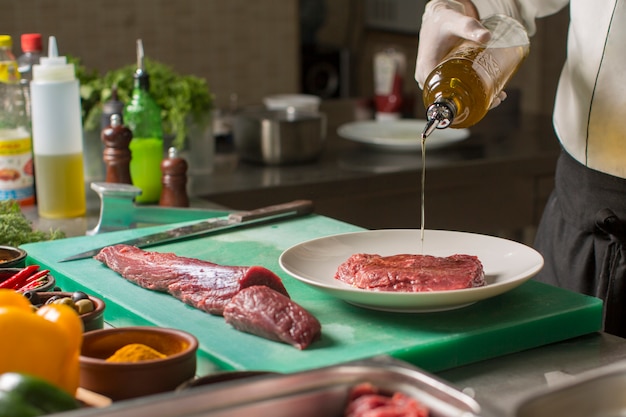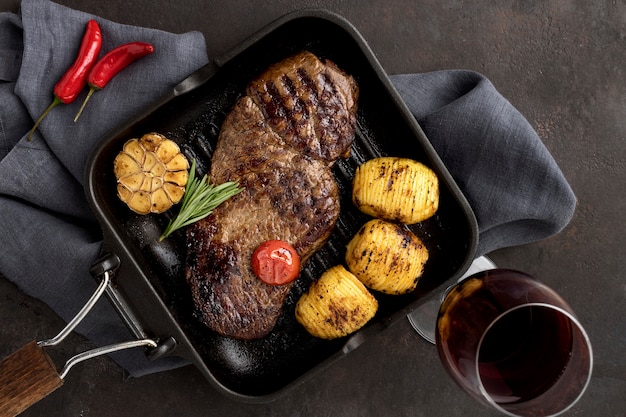You’re probably thinking, “prime rib? That sounds fancy, and probably too much work for a weeknight dinner.” But let me tell you, it's actually a surprisingly manageable dish that can become a real crowd-pleaser. Believe me, I've been there, trying to impress with a fancy dinner and ending up feeling stressed and overwhelmed. But once you get the hang of it, prime rib is a relatively easy dish to master. You'll be the talk of the town, I promise!
(Part 1) Picking the perfect prime rib

Understanding the Cuts
First, let's talk cuts. You want a "rib roast", the most prized cut for this dish. Now, there are two main types:
standing rib roast: This is the whole rib with the bone intact. It looks impressive and provides fantastic flavour. If you're going for a dramatic centerpiece, this is your guy.
Rib roast (bone-in or boneless): This is essentially a section of the rib roast, either with the bone in or removed. It's less showy but still delivers delicious results.
Size Matters
The size of your prime rib depends on your guest list. A 3-4 bone roast will feed 6-8 people, while a 7-8 bone roast can handle 12-16 comfortably.
Marbling: The Key to Juiciness
When you're at the butcher's, pay close attention to the "marbling" - those streaks of fat running through the meat. The more marbling, the better! It's this fat that melts during cooking, basting the meat and making it unbelievably tender and juicy.
A Butcher's Eye View
Don't hesitate to ask your butcher for advice. They are your experts! They can help you choose the right cut, size, and even give you tips on how to prepare it.
(Part 2) Seasoning Your Prime Rib

Salt: The Essential Seasoning
Now, let's talk seasoning. This is where a simple trick can transform your dish. Salt is king, my friend! It brings out the natural flavour of the meat in a way that nothing else can. Generously salt your prime rib, but don't go overboard, you don't want it to be too salty.
Pepper for Punch
After the salt, add some freshly ground black pepper. It adds a nice kick to the flavour and makes a noticeable difference.
Spice it Up (But Not Too Much!)
You can absolutely get creative with spices, but keep in mind that you don't want to overwhelm the natural flavour of the meat. A little garlic powder or onion powder can enhance the flavour, or even a touch of paprika for a splash of colour. Just remember, a little goes a long way!
(Part 3) Roasting Your Prime Rib: The Magic Happens Here

Setting the Stage for a Perfect Roast
Preheat your oven to 450°F (232°C). This high temperature sears the outside of the meat, giving it a beautiful crust.
Roasting Rack: A Must-Have
Place your prime rib on a roasting rack in a roasting pan. The rack ensures even cooking and lets the fat drip down, creating a delicious pan sauce. No need to add oil, the fat in the meat will render down nicely.
Initial Searing: The Key to Crispy Perfection
Roast for 15 minutes at the high temperature. This is a crucial step for achieving that incredible crispy exterior.
Lowering the Heat for Even Cooking
Now, lower the oven temperature to 325°F (163°C) and continue roasting. This lower temperature allows the meat to cook evenly and stay juicy.
Mastering the Timing: A Guide to Doneness
The roasting time will depend on the size of your prime rib and the doneness you prefer. Here's a general guide:
Rare: 15-17 minutes per pound
Medium Rare: 18-20 minutes per pound
Well Done: 20-22 minutes per pound
Don't Forget to Rest!
Once the prime rib is cooked, take it out of the oven and let it rest for 15-20 minutes before carving. This is absolutely crucial. It allows the juices to redistribute throughout the meat, making it even more tender and delicious.
(Part 4) Temperature Guide: Doneness Made Easy
meat thermometer: Your Best Friend
You don't want to overcook your prime rib, so a meat thermometer is your essential tool. Insert it into the thickest part of the meat, avoiding the bone, and check the temperature.
internal temperature Targets:
| Doneness | Internal Temperature (°F) | Internal Temperature (°C) |
|---|---|---|
| Rare | 125-130 | 52-54 |
| Medium Rare | 130-135 | 54-57 |
| Medium | 135-140 | 57-60 |
| Medium Well | 140-145 | 60-63 |
| Well Done | 145 | 63 |
The Importance of the Resting Time
Remember, the internal temperature will continue to rise slightly even after you remove the prime rib from the oven. That's why it's a good idea to take it out a few degrees below your desired target temperature.
(Part 5) Basting: Keeping Your Prime Rib Juicy and Delicious
The Art of Basting
Basting is the key to keeping your prime rib juicy and flavorful. You can use a variety of basting liquids, but my go-to is a simple mixture of beef broth and red wine. It adds depth and richness to the flavour.
Basting Technique: A Simple Routine
Every 30 minutes or so, remove the prime rib from the oven and spoon some of the basting liquid over it. This helps to keep the meat moist and adds a delightful aroma to your kitchen.
(Part 6) Carving: The Finishing Touch
Carving Tips for a Show-Stopping Presentation
Now, for the grand finale, carving your prime rib! It might seem intimidating, but trust me, it's not as difficult as you think. Grab a sharp carving knife, and get ready to impress your guests.
A Step-by-Step Guide:
1. Start by cutting the rib roast in half, along the bone.
2. Cut slices across the grain of the meat. The grain is the direction of the muscle fibres, and cutting against it makes the meat more tender.
Serving It Up
Arrange your carved prime rib on a platter, and don't forget to serve the delicious pan juices as a sauce.
(Part 7) Accompanying Dishes: Making It a Meal to Remember
Prime Rib Deserves the Best Sidekicks
A prime rib deserves some equally impressive side dishes. Roasted vegetables are a classic choice, complementing the richness of the meat beautifully. Think potatoes, carrots, asparagus, or even Brussels sprouts.
Side Dish Inspiration:
Here are some other ideas to round out your meal:
- Yorkshire pudding
- Garlic bread
- green beans
- sweet potato casserole
Sauce Options: A Final Touch of Flavour
A good sauce can truly elevate a prime rib. You can make a simple pan sauce using the drippings from the roasting pan, or try something more elaborate, like a horseradish sauce or a rich red wine sauce.
(Part 8) Wine Pairing: Choosing the Perfect Companion
Complementary Flavors:
Selecting the right wine to pair with your prime rib is crucial. You want a wine that complements the richness of the meat without overpowering it.
Wine Recommendations:
Here are a few ideas for your prime rib pairing:
- Cabernet Sauvignon: This classic pairing offers full-bodied flavour and tannins that complement the richness of the meat.
- Merlot: A softer and smoother choice than Cabernet, it still pairs well with the flavour of the meat.
- Zinfandel: A robust red with bold fruit flavours, it's a good choice for a prime rib with a bit of a bolder flavour profile.
- Syrah: A full-bodied red with peppery notes, it's a great choice for a prime rib with a bit of a bolder flavour profile.
- Bordeaux Blend: A blend of Cabernet Sauvignon, Merlot, and other grapes, it's a versatile wine that pairs well with a variety of prime rib dishes.
(Part 9) FAQs: Your Prime Rib Questions Answered
1. Can I cook a prime rib in a slow cooker?
While it might seem tempting, a slow cooker isn't the best tool for prime rib. The low and slow cooking process can make the meat tough and dry. A conventional oven is much better suited for roasting prime rib.
2. What if I don't have a roasting rack?
No problem! You can simply place the prime rib directly in the roasting pan. Just make sure it's not sitting in the juices.
3. How do I know if my prime rib is cooked to my liking?
Always use a meat thermometer to check the internal temperature. Insert it into the thickest part of the meat, avoiding the bone, and check the temperature against the guide in Part 4.
4. Can I freeze prime rib?
Absolutely! Wrap it tightly in plastic wrap and foil, and freeze it for up to 3 months. Thaw it in the refrigerator for a couple of days before cooking.
5. Can I cook prime rib in a cast iron skillet?
Technically, you can, but it's not ideal. The skillet might not be large enough to accommodate the entire roast, and the heat distribution may not be as even as in a conventional oven.
There you have it, my guide to the perfect prime rib! I hope it's given you the confidence to tackle this delicious dish. Remember, it's all about choosing a good quality cut of meat, seasoning it generously, and cooking it slowly and evenly. Enjoy!
Everyone is watching

Prime Rib Roast Cooking Time Chart: Per Pound Guide
Cooking TipsPrime rib roast. Just the name conjures images of lavish dinners, crackling fires, and hearty laughter. It’s ...

How Long to Bake Potatoes in the Oven (Perfect Every Time)
Cooking TipsBaked potatoes are a staple in my kitchen. They're incredibly versatile, delicious, and surprisingly easy to m...

Perfect Rice Every Time: The Ultimate Guide to Cooking Rice
Cooking TipsAs a self-proclaimed foodie, I've always been a bit obsessed with rice. It's the foundation of countless cuisi...

The Ultimate Guide to Cooking Asparagus: Tips, Techniques, and Recipes
Cooking TipsAsparagus. The mere mention of this spring delicacy conjures up images of vibrant green spears, crisp and burs...

Ultimate Guide to Cooking the Perfect Thanksgiving Turkey
Cooking TipsThanksgiving. Just the word conjures up images of overflowing tables laden with delicious food, the scent of r...
